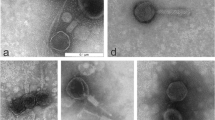Abstract
The genome of halo-forming temperate Pseudomonas aeruginosa phage phi297 and lytic activity of its virulent mutant were studied. A mosaic structure was revealed for phi297 genome by its complete sequencing. The phi297 genome was partly homologous to the genomes of phages D3 and F116. High lytic activity was assumed for temperate P. aeruginosa bacteriophage phi297 on the basis of morphological features of negative colonies. Virulent mutant phi297vir, which was capable of lysing the wild-type phage bacteria, was isolated. Lytic activity was compared for phi297 and the phages from commercial mixtures of two manufacturers (facilities of Nizhnii Novgorod and Perm’). Phage phi297 caused lysis of the mutant PAO1 bacteria that were resistant to the phages from commercial preparations, but the lytic activity spectrum of phi297 was narrower that the spectra of the commercial phages. The use of nonreverting virulent mutants of certain temperate bacteriophages was proposed for the treatment of P. aeruginosa infections.
Similar content being viewed by others
References
Sharibzhanova, T.O., Akhverdyan, V.Z., and Krylov, V.N., A Comparative Study of DNA Homology and Morphology of Pseudomonas aeruginosa Bacteriophages to Reveal Phylogenetic Relationships and for an Express Classification, Genetika (Moscow), 1992, vol. 28, no. 3, pp. 24–32.
Krylov, V.N., Sharibzhanova, T.O., and Akhverdyan, V.Z., Characterization of Homologous Regions in the Genomes of Several Species of Pseudomonas aeruginosa Temperate Bacteriophages, Genetika (Moscow), 1992, vol. 28, no. 3, pp. 33–42.
Krylov, V.N., Tolmachova, T.O., and Akhverdian, V.Z., DNA Homology in Species of Bacteriophages Active on Pseudomonas aeruginosa, Arch. Virol., 1993, vol. 131, nos. 1–2, pp. 141–151.
Akhverdyan, V.Z., Khrenova, E.A., Reulets, M.A., et al., Characteristics of the Pseudomonas aeruginosa Phags-Transpozons Belonging to Two Groups Differing in DNA-DNA Homology, Genetika (Moscow), 1985, vol. 21, no. 5, pp. 35–747.
Akhverdyan, V.Z., Lobanov, A.O., Khrenova, E.A., and Krylov, V.N., Recombinational Origin of Natural Transposable Phages of Related Species Belonging to Group B3 Active on Pseudomonas aeruginosa Bacteria, Russ. J. Genet., 1998, vol. 34, no. 5, pp. 697–700.
Akhverdian, V.Z., Khrenova, E.A., Lobanov, A.O., and Krylov, V.N., The Role of DNA Divergence on the Evolution of Transposable Phages of the Pseudomonas aeruginosa B3 Group, Russ. J. Genet., 1998, vol. 34, no. 6, pp. 699–701.
Pleteneva, E.A., Burkaltseva, V.B., Shaburova, O.V., et al., TL, the New Bacteriophage of Pseudomonas aeruginosa and Its Application for the Search of Halo-Producing Bacteriophages, Russ. J. Genet., 2011, vol. 47, no. 1, pp. 5–9.
Miller, J.H., Experiments in Molecular Genetics, New York: Cold Spring Harbor Lab., 1972.
Adams, M.H., Bacteriophages, New York: Interscience, 1959.
Sambrook, J., Fritsch, E.F., and Maniatis, T., Molecular Cloning: A Laboratory Manual, Cold Spring Harbor: Cold Spring Harbor Lab., 1989.
Byrne, M. and Kropinski, A.M., The Genome of the Pseudomonas aeruginosa Generalized Transducing Bacteriophage F116, Gene, 2005, vol. 14, no. 346, pp. 187–194.
Kropinski, A.M., Sequence of the Genome of the Temperate, Serotype-Converting, Pseudomonas aeruginosa Bacteriophage D3, J. Bacteriol., 2000, vol. 182, no. 21, pp. 6066–6074.
Newton, G.J., Daniels, C., Burrows, L.L., et al., Three-Component-Mediated Serotype Conversion in Pseudomonas aeruginosa by Bacteriophage D3, Mol. Microbiol., 2001, vol. 39, no. 5, pp. 1237–1247.
Burkaltseva, M.V., Pleteneva, E.A., Shaburova, O.V., et al., Conserved Genomes of φKMV-like Basteriorhages (T7 Subgroup) Active on Pseudomonas aeruginosa, Russ. J. Genet., 2006, vol. 42, no. 1, pp. 27–31.
Pleteneva, E.A., Krylov, S.V., Shaburova, O.V., et al., Pseudolysogeny of Pseudomonas aeruginosa Bacteria Infected with phiKZ-Like Bacteriophages, Russ. J. Genet., 2010, vol. 46, no. 1, pp. 20–25.
Krylov, V.N., Miroshnikov, K.A., Krylov, S.V., et al., Interspecies Migration and Evolution of Bacteriophages of the Genus φKZ: The Purpose and Criteria of the Search for New φKZ-Like Bacteriophages, Russ. J. Genet., 2010, vol. 46, no. 2, pp. 138–145.
Miller, R.V., Pemberton, J.M., and Clark, A.J., Prophage F116: Evidence for Extrachromosomal Location in Pseudomonas aeruginosa Strain PAO, J. Virol., 1977, vol. 22, no. 3, pp. 844–847.
Author information
Authors and Affiliations
Corresponding author
Additional information
Original Russian Text © M.V. Burkal’tseva, S.V. Krylov, A.M. Kropinski, E.A. Pleteneva, O.V. Shaburova, V.N. Krylov, 2011, published in Genetika, 2011, Vol. 47, No. 7, pp. 900–904.
Rights and permissions
About this article
Cite this article
Bourkal’tseva, M.V., Krylov, S.V., Kropinski, A.M. et al. Bacteriophage phi297, a new species of Pseudomonas aeruginosa temperate phages with a mosaic genome: Potential use in phage therapy. Russ J Genet 47, 794–798 (2011). https://doi.org/10.1134/S102279541106007X
Received:
Published:
Issue Date:
DOI: https://doi.org/10.1134/S102279541106007X




